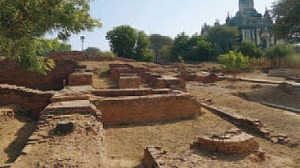
NABUNKEN NEWS vol.48
Technical investigation of the protection of Myanmar's cultural heritage
Myanmar (Burma) has been ruled by a military junta since about the 1960s. Especially since the 1990s, interaction between Myanmar and many Western countries and Japan has been almost completely blocked. Consequently, the actual condition of Myanmar's cultural heritage was unknown for a long period. However, the shift to civilian rule in March 2011 has drastically changed the situation, and the country has begun to experience successive waves of domestic foreign investment and development. As a result, cultural heritage has also become spotlighted.
As a multiethnic nation, Myanmar has a diversified range of tangible and intangible cultural heritages. Of special note, Bagan, which is located in the central region of the nation, is world famous, featuring the fantastic view of thousands of Buddhist constructions spread along both banks of the Irrawaddy River. For all that, at present, Myanmar has no cultural heritage inscribed on the UNESCO World Heritage List at all. It may be said that the cultural heritage of this country has not yet become known around the world. Another problem is that the recent rapid growth of Myanmar's economy raises a pressing question about how to properly protect the cultural heritage.
Accordingly, the Nara National Research Institute for Cultural Properties (Nabunken) dispatched seven staff members (five archaeologists and two conservation scientists) to Myanmar from January 26 to February 3, 2013, based on the "2012 Project for International Contribution to Cultural Heritage Protection (expert exchange)" led by the Agency for Cultural Affairs. During the period, Nabunken staff members had meetings with officials from cultural heritage-related authorities of Myanmar in order to exchange information as well as to carry out local surveys on many sites and museums in Yangon, Naypyidaw, Bagan, Beikthano, Pyu, and Srikshetra.
In fact, the Nabunken had already implemented joint research with Myanmar in accordance with the "Basic Investigation and Research on the Conservation and Improvement of the South Asian Buddhist Sites" project including personal exchange and local surveys from 1994 to 1998. Unfortunately, these personal exchanges were discontinued due to subsequent changes in Myanmar's political situation. However, the seeds we sowed during that roughly four year period have firmly taken root. We found that the experts once trained at the Nabunken are now in positions of leadership in Myanmar's cultural heritage-related authorities. In other words, the restart of personal exchange through this project brought about the "reunion with friends far apart".
Visiting the field, we realized that, despite a big difference existing in understanding and philosophy about cultural heritage between Myanmar and Japan, it is important to respect to that difference. For example, in Myanmar, even archaeologically precious and historical Buddhist temples and Buddha statues are cleaned and fixed. Moreover, some of them have been decorated with electric or neon lights. Although this esthetic sense is completely different from that of Japan, for the people of Myanmar, even a centuries-old cultural heritage remains an active object of their worship, and, hence, the cultural heritage should be decorated. In short, such sites are the "living heritage" for them.
The Nabunken would like to provide Myanmar with ongoing technical support, required for cultural heritage protection, in compliance with internationally approved standards, while respecting the differences referred to above.
(ISHIMURA Tomo, Department of Planning and Coordination)
 Shwedagon Paya decorated solemnly (Yangon, 15th century) |
 Royal palace site and Shwegugy Temple (Bagan, 12th century) |
